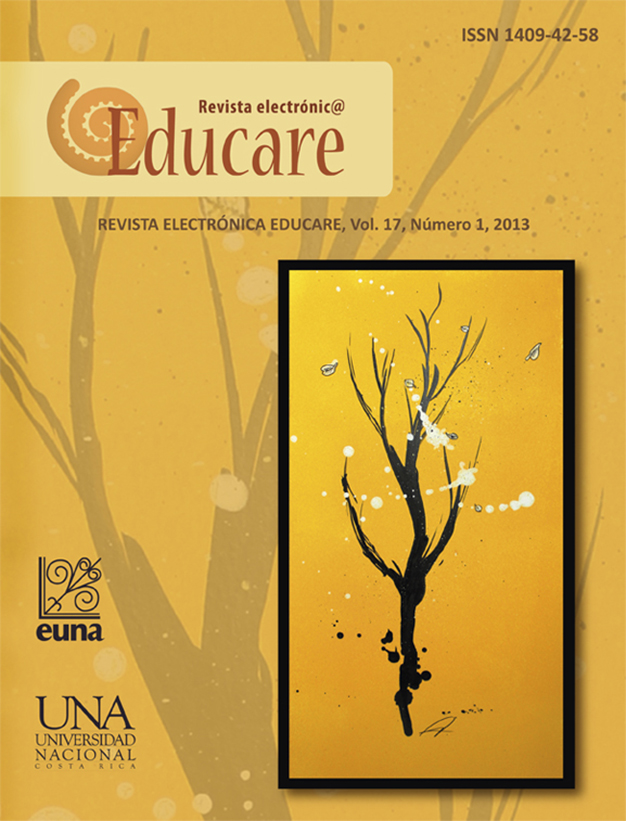An Overview of School Recess: What Children Think and Feel
DOI:
https://doi.org/10.15359/ree.17-1.4Keywords:
Recess, time, space, children, teachers, Educare Electronic Journal, Costa Rica.Abstract
Researchers of the Institute for Interdisciplinary Studies of Childhood and Adolescence (INEINA) have been interested in studying the current activities developed during recess time in public schools and what children require for this period from the point of view of the child population. This paper is the result from a research conducted on this matter with the participation of a group of children, in order to collect ideas from the participants and provide recommendations on possible strategies to enhance and strenghten recreation time at schools.
References
Aguilera, E. (2010). ¡Recreo!... ¡Vamos a jugar! Espacios y juegos: Una responsabilidad compartida.
Recuperado de http://www.colaborando.edu.ar/PcWeb/Contenido/Actividad44/File/
Recreo,%20vamos%20a%20jugar.pdf
Álvarez, F., Muñoz, F., Martínez, G., Trujillo, J. A., Echeverry, J. L. y Salazar, D. M. (2010). Proyecto
de lúdica, Tiempo libre y recreación. Colombia: Envigado. Recuperado de http://mua.
edu.co/mua/images/Archivos/docentes/edfisica/proyecto%20de%20ludica%20y%20
tiempo%20libre.pdf
Código de la niñez y la adolescencia (6 de febrero de 1998). La Gaceta Nº 26. Recuprado de
http://www.tse.go.cr/pdf/normativa/codigodelaninez.pdf
Convención sobre los Derechos del Niño. (2005). Lima, Perú: Save the Children.
Hernández, R., Fernández, C. y Baptista, P. (2010). Metodología de la investigación (5a
ed.). Perú:
McGraw-Hill.
Jarret, O. (2002). El recreo en la escuela primaria: ¿Qué indica la investigación? (Recess in Elementary
School: What Does the Research Say?). Champaing, IL: Eric Clearinghouse on Elementary
and Early Childhood Education. De la base de datos Eric Digests (ED467567). Recuperado
de http://www.eric.ed.gov/PDFS/ED467567.pdfh
Jarret, O. y Waite-Stupiansky, S. (2009). Recess—It’s Indispensable! [El recreo es imprescindible].
[Play, Policy, and Practice Interest Forum, NAEYC]. Recuperado de http://www.naeyc.org/
files/yc/file/200909/On Our Minds 909.pdf
National Association for Sport and Physical Education. (2006). Recess for Elementary School
Students [Recreo para los estudiantes de la escuela primaria]. Recuperado de http://www.
aahperd.org/naspe/standards/upload/Recess-for-Elementary-School-Students-2006.pdf
Pavía, V. (2005). El patio escolar: El juego en libertad controlada. Un lugar emblemático territorio
de pluralidad. Buenos Aires: Centro de Publicaciones Educativas y Material Didáctico.
Recuperado de http://books.google.co.cr/books?id=20hI47iJjgcC&printsec=frontcover&
source=gbs_ge_summary_r&cad=0 - v=onepage&q&f=false
Pérez, L. y Collazos, T. (2007). Los patios de recreo como espacios para el aprendizaje en las
instituciones educativas. Sedes Pablo Sexto en el Municipio de Dosquebradas. Universidad
Tecnológica de Pereira. Colombia. Recuperado de http://repositorio.utp.edu.co/dspace/
bitstream/11059/761/1/371621P438lp.pdf
Pica, R. (s. f.). 7 Reasons why Kids Need Recess [7 razones del porqué los niños necesitan el recreo].
Recuperado de http://www.selfgrowth.com/articles/7_Reasons_Why_Kids_Need_Recess.html
Reyes, J. I. (2005). La agresividad y violencia en los juegos de los niños durante el recreo escolar.
Recuperado de http://www.ucol.mx/egeneros/admin/archivos/agresividad_violencia_
juegos.pdf
Smaliroff, C. M. (s. f.). Juegotecas para los recreos escolares. Los recreos. Aprender y compartir.
Escuela Nueva Juan Mantovani. Recuperado de http://www.preveninos.com/Files_
Proyectos/Proy_256.pdf
Vicente, R. y Castro, M. (2010). Promoviendo los derechos de niños, niñas y adolescentes:
Conozcamos las leyes. Heredia, Costa Rica: Instituto de Estudios Interdisciplinarios de la
Niñez y la Adolescencia. Universidad Nacional.
Downloads
Additional Files
Published
How to Cite
Issue
Section
License
1. In case the submitted paper is accepted for publication, the author(s) FREELY, COSTLESS, EXCLUSIVELY AND FOR AN INDEFINITE TERM transfer copyrights and patrimonial rights to Universidad Nacional (UNA, Costa Rica). For more details check the Originality Statement and Copyright Transfer Agreement
2. REUTILIZATION RIGHTS: UNA authorizes authors to use, for any purpose (among them selfarchiving or autoarchiving) and to publish in the Internet in any electronic site, the paper´'s final version, both approved and published (post print), as long as it is done with a non commercial purpose, does not generate derivates without previous consentment and recognizes both publisher's name and authorship.
3. The submission and possible publication of the paper in the Educare Electronic Journal is ruled by the Journal’s editorial policies, the institutional rules of Universidad Nacional and the laws of the Republic of Costa Rica. Additionally, any possible difference of opinion or future dispute shall be settled in accordance with the mechanisms of Alternative Dispute Resolution and the Costa Rican Jurisdiction.
4. In all cases, it is understood that the opinions issued are those of the authors and do not necessarily reflect the position and opinion of Educare, CIDE or Universidad Nacional, Costa Rica. It is also understood that, in the exercise of academic freedom, the authors have carried out a rogorous scientific-academic process of research, reflection and argumentation thar lays within the thematic scope of interest of the Journal.
5. The papers published by Educare Electronic Journal use a Creative Commons License:














 The articles published by Educare Electronic Journal can be shared with a Creative Commons License:
The articles published by Educare Electronic Journal can be shared with a Creative Commons License: 



